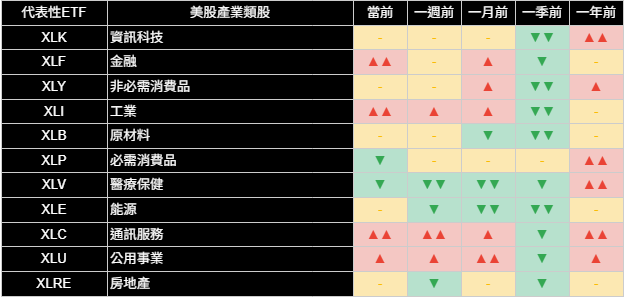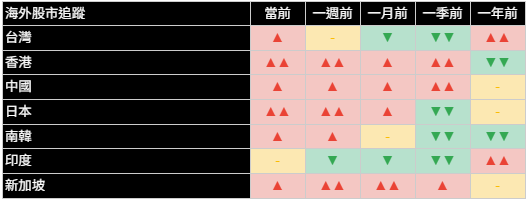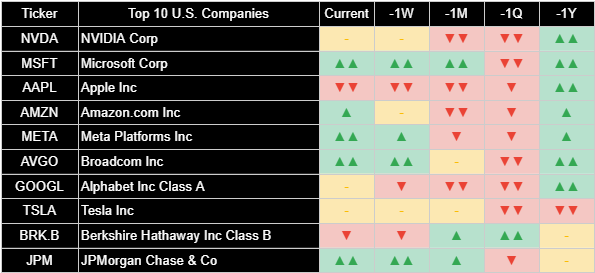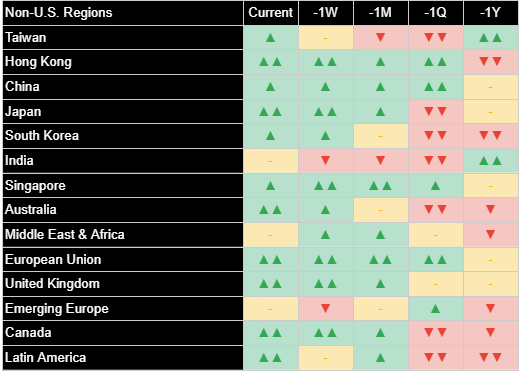【Joe’s華爾街脈動】通膨降溫也沒用!股市被「兩大黑手」拽下:地緣政治、貿易恐懼主導市場
疲弱的通膨報告不足以化解投資者的擔憂,油價上漲和美中貿易框架的不確定性對市場情緒構成壓力
Joe 盧, CFA 2025年6月11日 美東時間
重點摘要
- 儘管通膨報告利多(通常會提振股市),但由於地緣政治緊張局勢加劇和貿易政策的不確定性凌駕於利多消息,美國市場收低。
- 市場龍頭企業的領導地位正在分裂,少數幾家表現強勁的公司無法抵銷蘋果(Apple)等權值股的疲弱以及其他公司動能停滯的影響。
- 市場正在發生關鍵的資金輪動,投資者偏好金融和工業等對經濟敏感的類股,同時撤出防禦型的必需消費品類股。
- 在歐洲和日本的帶領下,國際市場普遍走強,為美國以外的市場創造了具吸引力的多元化投資機會。
- 資產表現出現明顯分歧,對經濟數據敏感的資產(如債券)上漲,而與地緣政治相關的資產(如原油)則飆升超過4%。
市場概覽
美國股市今日收黑,與早盤釋出的正面通膨報告形成反差。5月份消費者物價指數(CPI)低於市場預期,理應激勵市場上揚,因投資人通常將此視為聯準會可能趨向寬鬆的信號;然而,盤中漲勢未能持續至收盤。此種脫節顯示,投資者正在權衡正面的通膨數據與更複雜的地緣政治風險背景,以及對國際貿易的審慎樂觀情緒,導致收盤時市場呈現避險情緒。
今日的市場論述受到多重因素拉扯。一方面,市場傳出美中談判代表達成「框架」協議的消息,但因缺乏具體內容,樂觀情緒遭到抑制。更重要的是,美國與伊朗之間緊張局勢的升級為市場注入了新的不確定性,導致原油價格飆升。此一發展為能源類股帶來提振,使其在整體平盤至下跌的市場中脫穎而出,而固定收益市場則對溫和的通膨數據做出可預期的反應,各天期債券殖利率均告下滑。
整體市場指數

儘管通膨報告利多,美國主要股市基準指數未能守住早盤漲幅,終場收低。標普500指數(-0.29%)和那斯達克綜合指數(-0.34%)雙雙回落,而道瓊工業平均指數(0.00%)則收平。市場分析普遍認為,此疲弱的收盤表現顯示地緣政治擔憂蓋過了正面的經濟消息。從指標分析來看,儘管市場未能在利多消息下上漲是短期隱憂,但道瓊指數和標普500指數的潛在趨勢在過去一週已轉為正向,這是一個具建設性的訊號。相較之下,小型股持續的中性趨勢則顯示市場對全面上漲的信心仍然不足。
美國十大企業

大型股領導企業的表現顯著分歧。博通(Broadcom)(+3.38%)和微軟(Microsoft)(+0.36%)錄得上漲,延續其強勁的正面動能,但此漲幅被亞馬遜(Amazon.com)(-2.03%)和蘋果(Apple)(-1.92%)的疲弱所抵銷。分析指出,此種兩極分化突顯出一個更具辨別力的市場環境,企業自身的執行力比整體市場趨勢更為重要。表現不佳的個股,以及先前如輝達(NVIDIA)和Alphabet等領導股動能停滯所造成的拖累,顯示市場的領導地位脆弱,無法僅依賴少數幾檔股票來推動市場走高。
美國經濟指標


當前經濟前景正由正面的美國國內基本面與外部風險因素的衝突所形塑。低於預期的5月份通膨報告為美國聯準會提供了明確的彈性,使其得以考慮在今年稍晚降息。這得到了消費者信心穩定且正向趨勢的支持,消費者信心仍然是經濟的關鍵支柱。然而,我們對通膨趨勢的評估已趨緩至中性,反映出關稅可能帶來的風險。長天期資產高度負面的展望進一步突顯出債券市場對利率不確定性仍然極度敏感。
產業類股總覽

當日類股表現受到多重矛盾主題交錯影響。能源類股是明顯的例外,因原油價格在地緣政治消息刺激下飆升而上漲。其他方面,一項重要的資金輪動似乎正在進行中,投資者偏好金融和工業等對經濟敏感的類股,這兩者均展現不斷增強的正向趨勢。此種風險偏好情緒進一步得到防禦型必需消費品類股新出現的負面趨勢所證實。此種分歧顯示市場對經濟持久性具有潛在信心,但此由基本面驅動的轉變能否承受外部市場衝擊仍有待觀察。
國際市場


在全球市場,在美中貿易關係進展跡象的鼓勵下,漲勢正在持續擴大。貿易方面的建設性消息有助於提振整個亞洲市場的情緒,進一步增強了歐盟和日本早已展現的強大且持續的正面動能。這種國際市場全面性上行表現,顯示全球風險環境具建設性,並對純粹以美國為中心的投資方法提出挑戰。歐洲和日本持續的領導地位,加上主要亞洲市場前景的改善,為多元化投資提供了具吸引力的機會。
其他資產
資產表現清楚地反映了當日相互矛盾的市場論述。原油是當日波動最大的資產,因地緣政治緊張局勢升級的消息而飆升(+4.50%)。相較之下,固定收益市場則對疲弱的通膨數據做出反應,短期美國公債價格上漲(+0.16%)。黃金(+0.54%)小幅上漲,在較低的實質殖利率利多與複雜的風險背景之間取得平衡。債券市場因良好經濟數據而上漲,而石油市場則因地緣政治恐慌而飆升,此種分歧完美地概括了當前的投資氛圍。
保持聯繫並分享見解:
- 若您覺得本文有幫助,請點讚支持。
- 歡迎將此電子報轉發給可能覺得有價值的同事和朋友。
- 訂閱即可直接在您的收件匣中收到此分析。
- 在社群媒體上關注我們以獲取更多更新。
本電子報僅供參考,不構成任何證券或資產類別的投資建議或買賣推薦。文中所表達的觀點為作者截至發布日期的觀點,如有變動,恕不另行通知。所呈現的資訊乃基於從相信可靠的來源所獲取的數據,但其準確性、完整性和及時性不作保證。過往表現並非未來結果的指標。投資涉及風險,包括可能損失本金。讀者在做出任何投資決策前,應諮詢其財務顧問。作者及相關實體可能持有本文所討論的資產或資產類別的部位。
立即加入《Joe’s 華爾街脈動》LINE@官方帳號,獲得最新專欄資訊(點此加入)
關於《Joe’s 華爾街脈動》
鉅亨網特別邀請到擁有逾 22 年美國投資圈資歷、CFA 認證的機構操盤人 Joseph Lu 擔任專欄主筆。
Joe 為台裔美國人,曾管理超過百億美元規模的基金資產,並為總資產高達數千億美元的多家頂級金融機構提供資產配置優化建議。
Joe 目前帶領著由美國頂尖大學教授與博士組成的精英團隊,透過獨家開發的 "趨勢脈動 TrendFolios® 指標",為台灣投資人深度解析全球市場脈動,提供美股市場第一手專業觀點,協助投資人掌握先機。
Inflation Cools but Geopolitics and Trade Fears Dominate, Pushing Stocks Lower
A soft inflation report was not enough to overcome investor concerns, as rising oil prices and an uncertain U.S.-China trade framework weighed on sentiment.
By Joe 盧, CFA As of June 11, 2025
EXECUTIVE SUMMARY
- Despite a favorable inflation report that would typically boost equities, U.S. markets finished lower as rising geopolitical tensions and trade policy uncertainty took precedence.
- Leadership among the market's largest companies is fracturing, with a few strong performers unable to offset weakness from heavyweights like Apple and stalled momentum in others.
- A key rotation is underway in the market, with investors favoring economically sensitive sectors like Financials and Industrials while moving out of defensive Staples.
- International markets are showing broad-based strength, led by Europe and Japan, creating compelling diversification opportunities outside the U.S.
- Asset performance was sharply divided between assets sensitive to economic data, like bonds which rallied, and those tied to geopolitics, like crude oil which surged over 4%.
MARKET OVERVIEW
U.S. equity markets ended the day on a negative note, a counterintuitive outcome given the morning's encouraging report on inflation. The softer-than-expected May Consumer Price Index, which would typically fuel a rally on hopes of a more accommodative Federal Reserve, failed to sustain early gains. This disconnect suggests investors are weighing the positive inflation data against a more complex backdrop of geopolitical risks and cautious optimism surrounding international trade, leading to a risk-off sentiment by the closing bell.
The day's narrative was pulled in opposing directions. News that U.S. and Chinese negotiators had reached a "framework" agreement was tempered by a lack of detail. More significantly, escalating tensions between the United States and Iran injected fresh uncertainty, sending crude oil prices surging. This development provided a lift to the energy sector, which stood out in an otherwise flat-to-lower market, while the fixed-income market reacted predictably to the tame inflation data, with bond yields falling across the curve.
BROAD INDICES

Major U.S. equity benchmarks closed lower, failing to hold early gains despite a favorable inflation report. The S&P 500 Index (-0.29%) and Nasdaq Composite (-0.34%) both retreated, while the Dow Jones Industrial Average (0.00%) finished flat. This weak finish suggests geopolitical concerns outweighed positive economic news. While the market's inability to rally on good news is a near-term concern, underlying trends for the Dow and S&P 500 have turned positive over the last week, a constructive sign. However, the continued neutral trend for small-caps suggests conviction for a broad-based advance is still lacking.
TOP 10 U.S. COMPANIES

Performance among mega-cap leaders was notably divided. Broadcom (+3.38%) and Microsoft (+0.36%) posted gains, continuing their strong positive momentum, but this was offset by weakness from Amazon.com (-2.03%) and Apple (-1.92%). The bifurcation highlights a more discerning environment where company-specific execution matters more than broad market tides. The drag from underperformers and stalled momentum in former leaders like NVIDIA and Alphabet suggests the market's leadership is fragile and cannot rely on just a few names to drive it higher.
U.S. ECONOMIC INDICATORS

The economic landscape is being shaped by a positive domestic reality clashing with external risks. A softer-than-expected May inflation report provides the Federal Reserve with clear flexibility to consider rate cuts later this year. This is supported by a stable and positive trend in consumer strength, which remains a key pillar for the economy. However, our assessment of the inflation trend has moderated to neutral, reflecting potential risks from tariffs. The deeply negative outlook for long-duration assets further underscores that the bond market remains highly sensitive to interest rate uncertainty.
SECTOR OVERVIEW

Sector performance was dictated by the day's conflicting themes. The Energy sector was the clear outlier, gaining as crude oil prices surged on geopolitical news. Elsewhere, an important rotation appears to be underway, with investors favoring economically sensitive sectors like Financials and Industrials, both of which show strengthening positive trends. This risk-on appetite was further evidenced by a newly negative trend in the defensive Consumer Staples sector. The divergence signals underlying confidence in economic durability, but it remains to be seen if this fundamental-driven shift can withstand external market shocks.
INTERNATIONAL MARKETS

Global markets are showing broadening strength, spurred by signs of progress in U.S.-China trade relations. Constructive news on trade helped boost sentiment across Asia, adding to the powerful and persistent positive momentum already seen in the European Union and Japan. This broad-based international strength suggests a constructive global risk environment and challenges a purely U.S.-centric investment approach. The sustained leadership from Europe and Japan, now augmented by an improving outlook in key Asian markets, presents compelling opportunities for diversification.
OTHER ASSETS
Asset performance clearly reflected the day’s dueling narratives. Crude Oil was the day's biggest mover, surging (+4.50%) on news of escalating geopolitical tensions. In contrast, the fixed income market responded to the soft inflation data, with short-term Treasury bond prices rising (+0.16%). Gold (+0.54%) posted a modest gain, balancing the tailwind of lower real yields against a complex risk backdrop. The divergence between a bond market rallying on good economic news and an oil market spiking on geopolitical fears perfectly encapsulates the current investment climate.
Stay Connected & Share the Insights:
- Like this article if you found it helpful.
- Forward this newsletter to colleagues and friends who might find it valuable.
- Subscribe to receive this analysis directly to your inbox.
- Follow us on social media for more updates.
This newsletter is provided for informational purposes only and does not constitute investment advice or a recommendation to buy or sell any security or asset class. The views expressed are those of the author as of the date of publication and are subject to change without notice. Information presented is based on data obtained from sources believed to be reliable, but its accuracy, completeness, and timeliness are not guaranteed. Past performance is not indicative of future results. Investing involves risks, including the possible loss of principal. Readers should consult with their own financial advisors before making any investment decisions. The author and associated entities may hold positions in the assets or asset classes discussed herein.
Join the official LINE account of "Joe’s Wall Street Pulse" now to receive the latest column updates (click here to join)